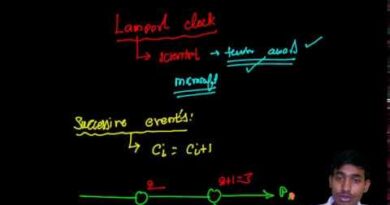Distributed System Architecture or Distributed System distributed application distributed computing.
Distributed System Architecture or Distributed System distributed application distributed computing.
Contents
- 0.1 Distributed System Architecture: An Overview
- 0.2 What is a Distributed System?
- 0.3 Key Concepts:
- 0.4 Types of Distributed System Architectures:
- 0.5 Characteristics of Distributed Systems:
- 0.6 Challenges in Distributed Systems:
- 0.7 Applications of Distributed Systems:
- 0.8 Conclusion:
- 0.9 Distributed System Architecture or Distributed System distributed application distributed computing.
- 0.10 Module 1 – Distributed System Architectures & Models
- 0.11 Distributed Systems [R17A0522] LECTURE NOTES
- 0.12 Distributed Computing
- 1 🌐 Distributed System Architecture
- 2 💻 Distributed Computing
- 3 🧾 Distributed Applications
- 4 🧠 Key Characteristics of Distributed Systems
- 5 📊 Use Cases:
- 6 📩 Want a visual diagram, notes, or quiz?
Distributed System Architecture: An Overview
What is a Distributed System?
A distributed system is a network of independent computers that work together to achieve a common goal. These systems communicate and coordinate their actions by passing messages.
Key Concepts:
- Distributed Application: Software that runs on multiple computers within a distributed system. Examples: Online gaming platforms, cloud-based services.
- Distributed Computing: The computational process where multiple systems work collaboratively to solve a problem. Examples: Bitcoin mining, SETI@home.
Types of Distributed System Architectures:
- Client-Server Model: Clients request services, and servers respond. Example: Web applications.
- Peer-to-Peer (P2P): All nodes act as both clients and servers. Example: Torrent networks.
- Three-Tier Architecture: Divides into three layers—Presentation, Logic, and Data. Example: E-commerce applications.
- Multi-Tier Architecture: Extension of three-tier with more complex layers for scalability. Example: Enterprise-level applications.
- Microservices Architecture: Independent services communicate through APIs. Example: Netflix, Amazon.
Characteristics of Distributed Systems:
- Scalability: Can expand by adding more nodes.
- Fault Tolerance: Handles failures and maintains functionality.
- Transparency: Users experience it as a single system.
- Concurrency: Multiple operations run simultaneously.
- Reliability: Ensures accurate and consistent results.
Challenges in Distributed Systems:
- Network Latency: Delay in data transmission.
- Security Issues: Data breaches and unauthorized access.
- Data Consistency: Maintaining data accuracy across nodes.
- Synchronization: Coordinating processes and data.
Applications of Distributed Systems:
- Cloud Computing: AWS, Microsoft Azure
- Distributed Databases: Google Bigtable, Amazon DynamoDB
- Telecommunication Networks: VoIP, Skype
- Scientific Computing: Large-scale simulations, genome analysis
Conclusion:
Distributed systems form the backbone of modern computing, providing scalability, reliability, and efficiency. As technology advances, their importance continues to grow across various domains.
If you need detailed explanations on any specific part, feel free to ask!
Distributed System Architecture or Distributed System distributed application distributed computing.
Module 1 – Distributed System Architectures & Models
Distributed Systems [R17A0522] LECTURE NOTES
Distributed Computing
Sure! Here’s a clear and concise explanation of Distributed System Architecture, including key terms like Distributed Application and Distributed Computing — ideal for understanding concepts for GATE, university exams, or interviews.
🌐 Distributed System Architecture
✅ What is a Distributed System?
A Distributed System is a collection of independent computers that appear to the users as a single coherent system. These computers communicate and coordinate through a network.
🏗️ Architecture of Distributed System
There are several types of distributed system architectures:
1. Client-Server Architecture
-
Client: Sends request
-
Server: Processes and responds
📌 Example: Web Browser (Client) ↔ Web Server
2. Three-Tier Architecture
-
Tier 1: Client (UI)
-
Tier 2: Application Server (Business Logic)
-
Tier 3: Database Server (Data Storage)
📌 Used in web and enterprise apps
3. Peer-to-Peer (P2P) Architecture
-
Every node is both a client and server
-
Direct sharing of resources among peers
📌 Example: BitTorrent, blockchain systems
4. Multi-Tier Architecture (n-tier)
-
Breaks down the system into multiple layers
-
Each tier is responsible for a separate concern
5. Service-Oriented Architecture (SOA) / Microservices
-
System is composed of loosely coupled services
-
Each service performs a specific function
📌 Used in cloud-native applications (e.g., Netflix)
💻 Distributed Computing
Distributed computing is the processing of data across multiple machines that work together to solve a problem.
🔹 These systems are scalable, reliable, and fault-tolerant
🔹 Uses include: big data, cloud computing, blockchain, scientific simulations
🧾 Distributed Applications
Applications built to run on distributed systems — parts of the app are spread across multiple devices.
Examples:
-
Google Search
-
Amazon Web Services (AWS)
-
Online banking systems
🧠 Key Characteristics of Distributed Systems
| Characteristic | Description |
|---|---|
| Scalability | Can grow easily by adding more nodes |
| Fault Tolerance | Keeps working even if one node fails |
| Concurrency | Many tasks run in parallel |
| Transparency | Users see it as a single system |
📊 Use Cases:
-
Cloud services (Azure, AWS, GCP)
-
IoT systems
-
Multiplayer online games
-
Distributed databases (Cassandra, MongoDB)
📩 Want a visual diagram, notes, or quiz?
I can provide:
-
🖼️ Architecture diagrams
-
📄 PDF notes or slide deck
-
🧪 MCQs and interview questions
Let me know your need!


